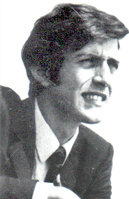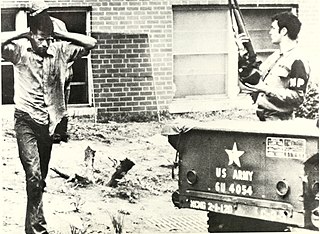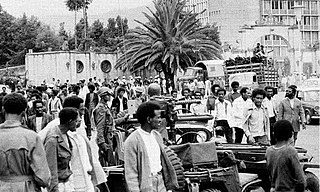Intifada is an Arabic word for a rebellion or uprising, or a resistance movement. It can be used to refer to an uprising against oppression.

Beginning in May 1968, a period of civil unrest occurred throughout France, lasting seven weeks and punctuated by demonstrations, general strikes, and the occupation of universities and factories. At the height of events, which have since become known as May 68, the economy of France came to a halt. The protests reached a point that made political leaders fear civil war or revolution; the national government briefly ceased to function after President Charles de Gaulle secretly fled France to West Germany on the 29th. The protests are sometimes linked to similar movements around the same time worldwide that inspired a generation of protest art in the form of songs, imaginative graffiti, posters, and slogans.

Student activism or campus activism is work by students to cause political, environmental, economic, or social change. In addition to education, student groups often play central roles in democratization and winning civil rights.

Jan Palach was a Czech student of history and political economics at Charles University in Prague. His self-immolation was a political protest against the end of the Prague Spring resulting from the 1968 invasion of Czechoslovakia by the Warsaw Pact armies.

Opposition to United States involvement in the Vietnam War began with demonstrations in 1965 against the escalating role of the United States in the Vietnam War and grew into a broad social movement over the ensuing several years. This movement informed and helped shape the vigorous and polarizing debate, primarily in the United States, during the second half of the 1960s and early 1970s on how to end the Vietnam War.
In 1968, a series of protests at Columbia University in New York City were one among the various student demonstrations that occurred around the globe in that year. The Columbia protests erupted over the spring of that year after students discovered links between the university and the institutional apparatus supporting the United States' involvement in the Vietnam War, as well as their concern over an allegedly segregated gymnasium to be constructed in the nearby Morningside Park. The protests resulted in the student occupation of many university buildings and the eventual violent removal of protesters by the New York City Police Department.

Kostas Georgakis was a Greek student studying geology in Italy. On 26 July 1970, while in Italy, he gave an interview denouncing the dictatorial regime of Georgios Papadopoulos. The junta retaliated by attacking him, pressuring his family, and rescinding his military exemption. In a final, fatal, protest in the early hours of 19 September 1970, Georgakis set himself ablaze in Matteotti square in Genoa. He died later that day, an estimated 1,500 people attended his 22 September funeral, with hundreds of anti-junta resistance members leading a demonstration. Melina Mercouri carried a bouquet for the hero of the anti-junta. After being briefly interred in Genoa his remains were transported by ship to Corfu, and on 18 January 1971 he was buried. After the junta collapsed the Government of Greece erected a monument and plaque in his home town of Corfu, another plaque was placed in Matteotti square, and multiple poems have been written in his honor.
Activism has played an important role in the history of Ohio Wesleyan University; The founders of Ohio Wesleyan University expressed a hope that the university "is forever to be conducted on the most liberal principles." OWU has espoused activism in its academic philosophy. Alumni of the school have prominently engaged in controversial issues of their times on three central issues—the scope of justice; distributive justice based on race, gender, and income; and institutions related to preserving social structures.

The student strike of 1970 was a massive protest across the United States that included walk-outs from college and high school classrooms, initially in response to the United States expansion of the Vietnam War into Cambodia. Nearly 900 campuses nationwide participated. The strike began May 1, but increased significantly after the shooting of students at Kent State University by National Guardsmen on May 4. While many violent incidents occurred during the protests, they were, for the most part, peaceful.
The Black Student Movement (BSM) is an organization at the University of North Carolina at Chapel Hill. It is the second largest student-run organization and one of the largest cultural organizations on the school's campus. The organization was created on November 7, 1967 to combat problems of black recruit, admissions, and integration on UNC-CH campus.
Richard T. Drinnon was professor emeritus of history at Bucknell University. He also taught at the University of California, Berkeley, where he taught courses on American history. He was denied tenure due to his political activism and was about to be called up by the House Un-American Activities Committee. Drinnon participated in the Columbia University protests of 1968, and he published several books, including "Rebel in Paradise: A Biography of Emma Goldman" and "Facing West: The Metaphysics of Indian-Hating and Empire-Building."

The 1969 Greensboro uprising occurred on and around the campuses of James B. Dudley High School and North Carolina Agricultural and Technical State University (A&T) in Greensboro, North Carolina, when, over the course of May 21 to May 25, gunfire was exchanged between student protesters, police and National Guard. One bystander, sophomore honors student Willie Grimes, was killed, although whether he was killed by police or protesters remains unknown.

Activism consists of efforts to promote, impede, direct or intervene in social, political, economic or environmental reform with the desire to make changes in society toward a perceived greater good. Forms of activism range from mandate building in a community, petitioning elected officials, running or contributing to a political campaign, preferential patronage of businesses, and demonstrative forms of activism like rallies, street marches, strikes, sit-ins, or hunger strikes.

The Teaching Assistants Association (TAA) is a graduate student employee union formed at the University of Wisconsin–Madison in 1966. It is credited as the first graduate student labor union. Following voluntary recognition by the university as the teaching assistants' bargaining agent in 1969, negotiations resulted in a 1970 strike, which secured "bread-and-butter" gains such as job security alongside grievance procedures. Their major unmet demand from their strike—the inclusion of teaching assistants and students in the course planning process—went unfulfilled. The TAA struck again in 1980 and lost its union recognition until 1986. The union's protest at the Wisconsin State Capitol building began the 2011 Wisconsin protests.
The Third World Liberation Front (TWLF) rose in 1968 as a coalition of ethnic student groups on college campuses in California in response to the Eurocentric education and lack of diversity at San Francisco State College and University of California, Berkeley. The TWLF was instrumental in creating and establishing Ethnic Studies and other identity studies as majors in their respective schools and universities across the United States.

In 1968 and 1969, student protests at several Japanese universities ultimately forced the closure of campuses across Japan. Known as daigaku funsō or daigaku tōsō, the protests were part of the worldwide protest cycle in 1968 and the late-1960s Japanese protest cycle, including the Anpo protests of 1970 and the struggle against the construction of Narita Airport. Students demonstrated initially against practical issues in universities and eventually formed the Zenkyōtō in mid-1968 to organize themselves. The Act on Temporary Measures concerning University Management allowed for the dispersal of protesters in 1969.
Columbia University in New York City, New York, has seen numerous instances of student protests, particularly beginning in the late 20th century.

The Yu Zisan Incident, also known as Yu Tse-san Incident, was a series of political events ignited by the death of Yu Zisan, then 23-year-old chairman of the Students' Autonomous Association (SAA) at National Che Kiang University (NCKU) during the Chinese Civil War. Suspected of links with communist factions, Yu was detained on 25 October 1947 at Hangzhou Garrison Headquarters and died there five days later. The Nationalist government asserted that Yu committed suicide fearing conviction, a claim the university did not endorse. His death, widely seen as a government effort to quell student activism, sparked widespread anti-government protests across China in November and December 1947.

The Ethiopian Student Movement was a period of radical Marxist–Leninist student activism and movement in Ethiopia from the mid-1960s to the 1974 revolution. The first demonstration occurred in 1965 by university student, led by Marxist–Leninist motivation chanting "Land to the Tiller" and "Is poverty a crime?". The student uprisings continued in 1966 until 1969. The movement also called for the abolish of monarchy under Emperor Haile Selassie and feudalism in Ethiopia.














